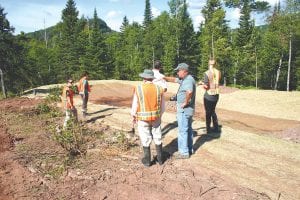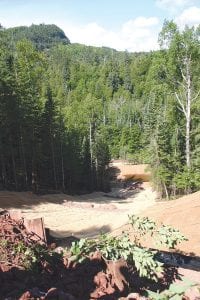A representative of the Great Lakes Commission that provided a large grant in 2010 for erosion control projects on the Poplar River in Lutsen took a tour of the projects on August 6. Left: A tightline – a pipe underneath the ground – has been installed this summer as part of the Caribou Highlands Flowpath project. Above: Representatives of Cook County Soil & Water and the Poplar River Management Board along with Gary Overmeier of the Great Lakes Commission and engineering consultant Curt Sparks view a specially designed ditch that diffuses the energy of water running beside a narrow maintenance roadway that traverses the hillside. The system includes culverts, collection basins, and rock-lined channels that direct the water and reduce the force of its flow.

Gary Overmeier, senior project manager with the Great Lakes Commission (GLC), traveled from Ann Arbor, Michigan to take a tour of the work being done to reduce sediment in the Poplar River. His visit on August 6, 2013 was the first in a series of four visits to places that received U.S. Environmental Protection Agency (EPA) Great Lakes Restoration Initiative grant funding over the last several years.
The Cook County Soil & Water District, in partnership with the Poplar River Management Board (PRMB), planned four large projects for the $687,037 they were awarded in 2010. With projects coming in under budget, the possibility of a fifth project is being discussed.
“The projects to be completed by this GLC grant have the potential to reduce enough sediment loading to make the Poplar River the first water body in Minnesota to be taken off the EPA 303(d) [impaired and threatened waters] list,” according to a document outlining the projects. This was one of the first Great Lakes Restoration Initiative projects the Great Lakes Commission approved.
The Ullr Tightline project was completed last summer. It consists of a large buried pipeline that carries storm water from a collection basin down the hill to a concrete energy-dissipating vault near the bottom, which discharges water to a rock-lined channel just above the river. It is expected to reduce sediment in the Poplar River by 90 tons a year. PRMB President Tom Rider, co-owner of Lutsen Mountains, said that the new system, which is on ski hill property, worked as it was intended during a recent 5-inch rain.
Cook County Soil & Water Conservation District Manager Kerrie Berg conducted a tour of the project currently under construction, called the Caribou Highlands Flowpath. It consists of a series of collection basins, ditches, culverts, a buried pipeline, and rock-lined catchment areas that direct water and dissipate its intensity as it makes its way down the hill. It is expected to reduce sediment by 80 tons a year. Barr Engineering created the design and is supervising the work, which is being done by Reuben Johnson & Son Inc. of Superior, Wis.
The Lower Eagle Mountain Road project, expected to reduce sediment by 75 tons a year, was awarded to Edwin E. Thoreson Inc. and is slated to be done by August 30. The fourth project, the Mystery Mountain Flowpath, was ready to be bid out and is expected to reduce sediment by another 30 tons a year.
With previous projects that have been completed, sediment in the Poplar River has been reduced by 660 tons a year so far.
Property owners will need to maintain the projects over time in order for them to remain effective.
Tom Rider suggested that one of the next projects could be a refinement of the modeling that has been done on the impact of the ski runs. “It’s enormously complex,” he said of the calculations involved in creating scientific models of the interaction of water, slope, vegetation, ground permeability, and gravity.
Engineering consultant Curt Sparks said, “This is really the only mountainous area in the Midwest.” The large grant-funded projects are complemented by smaller erosion control measures such as water bars on the ski hills. Some roads have been abandoned to reduce erosion as well.
Gary Overmeier said that this region of the country is experiencing severe storms that dump a lot of water in short periods of time. We need to prepare to deal with these kinds of storms, he said.
At the meeting, the PRMB spent some time strategizing how it could make the most of grant opportunities coming up. Engineer Sparks recommended that they keep up the momentum of the grants by not letting a construction season go by without doing a project. “I really think it’s important to continue to move forward,” he said. “We are seeing results.” He thought the Poplar River could be delisted as early as 2015.
As various projects have been completed, the Minnesota Pollution Control Agency (MPCA) has been working on a Total Maximum Daily Load (TMDL) standard for how much sediment a river can handle in a healthy way. The TMDL must be approved by the EPA. Curt Sparks said that the fact that so much has been done before the new standard is even set means that “we’ve just got a great track record here.” He pointed out that the PRMB pushed successfully for an “averaging” system and a regional approach – a standard that was realistic and that reflected the unique and varying conditions in the Poplar River.
Karen Evens of the MPCA said she expects public hearings on the TMDL to be held this next fall and winter. “Protecting what we have is a good thing,” she said, “and improving what we have is good work.” She admitted that the standards might be high, but they will keep this area from the environmental degradation that exists in other places.



Leave a Reply